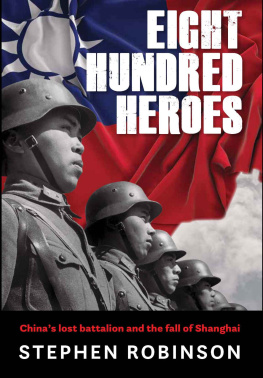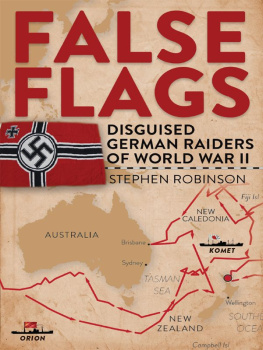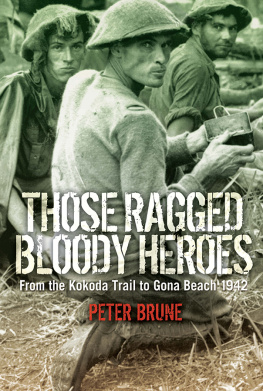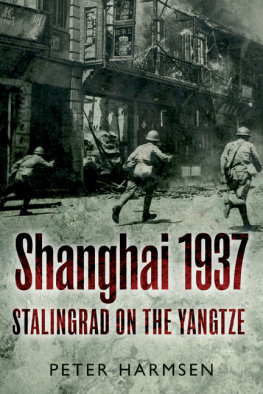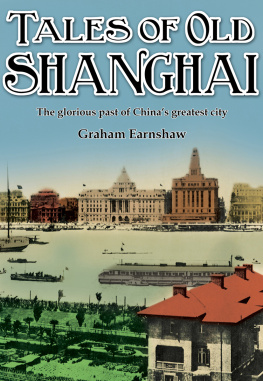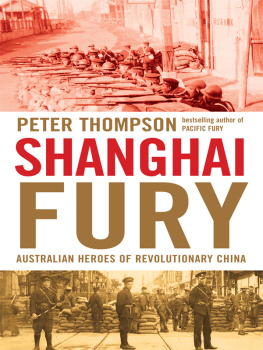Dedicated to Emeritus Professor Edmund S.K. Fung FAHA,
an inspirational teacher of Chinese history

German-equipped Chinese soldiers run past Sihang Warehouse.
(Authors Collection)
CONTENTS
INTRODUCTION

Go tell the Spartans, stranger passing by, that here, obedient to their laws, we lie.
Epitaph for the 300 Spartans
China will not die, China will not die,
Look at our national hero Lieutenant Colonel Xie. China will not die, China will not die,
Watch the eight hundred heroes of the lone battalion fight for every inch of land,
From four sides come the gunfire, from the four sides come the wolves,
They would rather die than retreat, they would rather die than surrender.
Amidst the sea of chaos our nations flag flies proudly, flies proudly, flies proudly, flies proudly.
Eight hundred heroic hearts all beat as one, unstoppable to the thousands of enemies,
Our actions are mighty, our integrity heroic Comrades, arise! Comrades, arise!
Lets answer the call to arms, and follow the example of the eight hundred heroes
China will not die, China will not die!
Song of the 800 Heroes
AN EPIC LAST STAND
In October 1937 a battalion of around 420 Chinese soldiers led by the stoic 32-year-old Lieutenant Colonel Xie Jinyuan defended Sihang Warehouse in Shanghai against an overwhelming force of invading Japanese troops. The lone battalion, comprised of soldiers from the elite 88th Division, were loyal to the Republic of China, ruled by Chiang Kai-sheks Kuomintang (Nationalist) Government. As these determined men fought the Japanese with intense bravery, the rest of the Chinese Army withdrew from the city. However, as the isolated Chinese detachment was only a small force, they informed the outside world that 800 soldiers were defending the warehouse in order to deceive the Japanese into not realizing their true number. This successful ruse created the legend of the Eight Hundred Heroes and their demonstration of valour raised Chinese morale during the first year of the long Sino-Japanese War (193745).
The Eight Hundred Heroes performed an incredible feat of heroism that quickly gained international fame and sympathy. Even before the fighting ended, The New York Times declared: The stand of the battalion stirred Shanghai Chinese to patriotic frenzy.
The defence of Sihang Warehouse in military terms was a minor incident during a titanic conflict that claimed the lives of between fifteen and twenty million Chinese people a scale of human suffering beyond comprehension. The action took place during the Battle of Shanghai, a brutal urban conflict which lasted almost three months, resulting in over 187,000 Chinese and 32,000 Japanese casualties. Although Japan emerged victorious, their triumph was a pyrrhic victory as the Japanese Empire became overextended in a war it could not win without a workable strategy to end the conflict on favourable terms, fighting an enemy that refused to capitulate. Chinese soldiers in Shanghai demonstrated that they could successfully resist Japanese troops, which surprised many observers. Japan announced that she would finish her campaign in China in three months, an American journalist reported during the war. Some American experts believed Japan. They watched the Shanghai battle during that summer of 1937 and waited for Shanghai to fall like a house of cards. But it didnt fall so easily. The Eight Hundred formed a core part of this narrative as the reporter continued: The story of the lone battalion which held out in a warehouse against the rest of a captured city was blazoned across the newspapers of the world.

Lieutenant Colonel Xie Jinyuan, commander of the Eight Hundred Heroes.
(Authors Collection)
The defence of Sihang Warehouse more than any other event symbolized Chinese defiance during the long years of war as Lu Pan explained:
Although the Chinese eventually lost the battle, the warehouse became the symbol of the tenacious spirit of national resistance in the enemy-occupied Shanghai. Later, it emerged as a highly mythologized narrative in the whole Sino-Japanese War propaganda effort.
The Eight Hundred personified the David versus Goliath nature of the conflict with a clear underdog standing up against a powerful aggressor, a narrative that naturally generates sympathy, and this was no accident as their last stand occurred precisely to capture the imagination of the world.

Sihang Warehouse on the bank of Suzhou Creek seen from Shanghais International Settlement.
(Contributor: Imaginechina Limited/Alamy Stock Photo)
Sihang Warehouse is located on the bank of Suzhou Creek, which separated the Chinese districts of Shanghai from the International Settlement, dominated by the British and American concessions. Less than 70 metres separated the Eight Hundred from a neutral cosmopolitan metropolis and its large foreign community. Inside the relative safety of the Settlement, the population watched the inferno of destruction across the creek from the rooftops of buildings including the citys most glamorous hotels.
The international press in Shanghai covering the conflict lived a surreal existence, as the American journalist Edgar Snow explained: It was as though Verdun had happened on the Seine, in full view of a Right Bank Paris that was neutral; as though a Gettysburg were fought in Harlem, while the rest of Manhattan remained a non-belligerent observer.

Westerners watch the fighting in Shanghai from a rooftop in the International Settlement.
(Authors Collection)
The Chinese leadership understood how the war in Shanghai was being reported when it ordered the Eight Hundred to defend Sihang and it hoped to create an international media sensation, which is precisely what occurred. The warehouse was perfectly located to achieve this aim and reporters from the English language North China Daily News actually watched the fighting from the roof of their own office building. Reporters had the perfect vantage point to witness the spectacle, as an American newspaper explained in sensationalistic terms when advertising a screening of documentary footage taken during the fighting:

Two westerners watch the fighting in Shanghai from a rooftop in 1937.
(Contributor: Historic Collection/Alamy Stock Photo)
The greatest battle of the Sino-Japanese War ends with the greatest conflagration the Far East has ever seen under constant fire, Movietones cameramen film sensational fight to the death for the first time, actual pictures of hand-to-hand combat the heroic last stand of Chinese suicide battalion, trapped and doomed to destruction in a warehouse attack and counter-attack amid a hail of bullets and grenades Japanese shells and bombs smash a city before your eyes fires rage unchecked an inferno in a city of millions and civilians, the innocent victims, fleeing, driven, machine-gunned and bombed, their homes a shambles, seek shelter from the slaughter, in a land where terror reigns.

